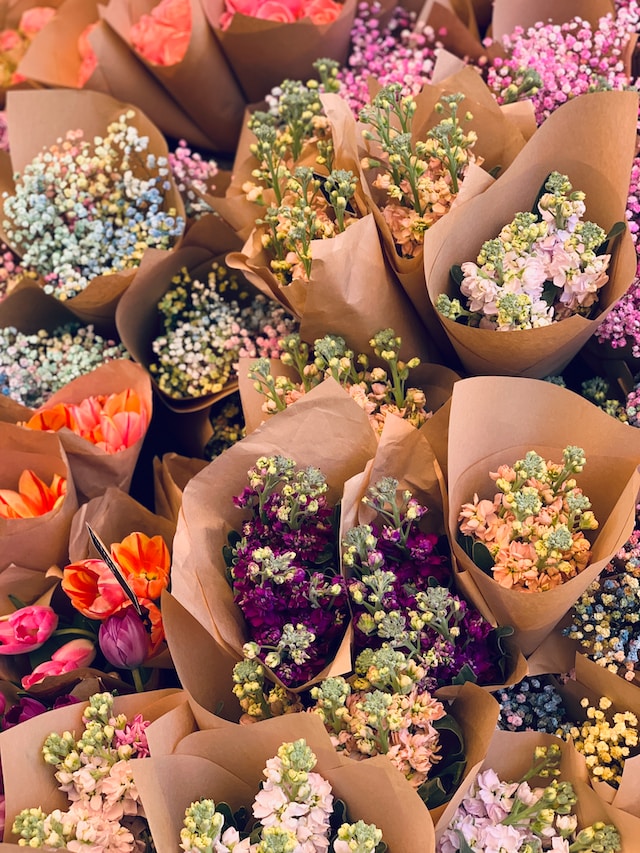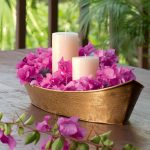Home decor trends come and go, but the classic floral arrangement is one element of interior design that will always maintain its timeless charm.
Whether you opt for real or artificial blooms, these decorative accents uniquely elevate the ambiance of any room in your house.
To achieve the desired effect, it’s essential to carefully select the right type of flowers and pair them with the perfect vase.
The synergy between the flower choice and the vase style can significantly enhance your chosen interior aesthetic. If you want to decorate your house with flowers, you can get them on My Global Flower.
The best part of this platform is that you can buy and send flowers. For instance, you must select the location for same day flower delivery in Perth.
Suppose you need help deciding whether to embrace a modern, minimalist vibe or to go all out with vibrant and bold selections, here. In that case, we’ll explore creative and inspiring ways to incorporate the beauty of flowers into your home seamlessly.
The Welcoming Entryway
Foyers and entryways play a pivotal role in the home, serving as the welcoming gateway where both guests and residents receive their initial introduction to the interior of the dwelling.
You can use this space to accept guests with flowers as decoration. This not only helps to lift the heavy atmosphere but also has a soothing sensation.
Furthermore, It’s a space where functionality meets aesthetics, and it’s common to find furnishings and accessories such as coat racks, shoe benches, and key organizers here. These items are essential for keeping the space organized and comfortable for everyone while providing a convenient spot to store outdoor essentials.
In homes with limited square footage, foyers and entryways are often integrated into other living areas, like the living room or kitchen, rather than standalone rooms. This spatial constraint can present challenges when incorporating the necessary functional elements.
Hence, it’s common to see multifunctional entryway furnishings that efficiently use the available space to fulfill several roles.
On the other hand, larger homes with dedicated foyers enjoy the luxury of more room to work with. These grand entryways are not only equipped for storage but also serve as an opportunity to make a design statement. They act as “stage-setters,” creating a grand first impression with striking focal points and impressive decor choices.
Elements such as sculptures, lush indoor plants, captivating paintings, and oversized mirrors are favored options for enhancing the visual appeal of these entryways.
The Inviting Living Room
Family and living rooms are significant in our homes, often serving as the epicenter of social activity and relaxation. These spaces are where families come together and children play, and in many households, dining has made its way from the traditional dining room to the living room.
These rooms’ versatility and extensive use have spurred a shift in their design focus. Comfort and functionality are at the forefront, with trends moving from low, delicate coffee tables to larger, soft ottomans or adaptable tables that can be raised to dining height.
With the need to accommodate a variety of activities, storage solutions have become more integral. Furniture pieces are designed to house toys, pet essentials, and hobby-related items, and built-in shelving has gained popularity to provide both storage and aesthetic appeal.
Since living rooms often boast the most square footage, homeowners are increasingly capitalizing on this space to introduce additional features.
Bars, cozy reading nooks, designated pet corners, and various recreational zones are becoming commonplace. The living room may serve dual purposes in smaller homes with limited space, functioning as a home gym or office area.
The living room’s role has evolved beyond mere lounging and entertainment. It has adapted to meet modern families’ changing needs and lifestyles, embracing multifunctionality and creativity.
These spaces are now designed to cater to a range of activities, providing comfort and utility while allowing homeowners to put their stamp on their living environment.
The Cozy Bedroom
The master bedroom is undeniably the sanctuary within a home, providing a haven for the head of the household to escape, relax, and recharge. What truly sets this bedroom apart is the en suite bathroom, a private oasis that adds a touch of luxury and exclusivity. Design considerations in the main bedroom often revolve around creating a personal retreat.
One of the primary focal points in the design of a main bedroom is the en suite bathroom. It’s here that a sense of seclusion and privacy is meticulously crafted.
The goal is to make the main bedroom and its accompanying bathroom a harmonious space that caters to personal relaxation and comfort.
Panoramic windows are common in master bedrooms, offering captivating views of the surroundings. These expansive windows often grant an unobstructed vista, allowing residents to enjoy the scenery right from their bed or, in more spacious suites, from separate seating areas.
Including such windows enhances the aesthetics and connects the occupant with the natural world outside, fostering a tranquil atmosphere.
In recent years, master bedrooms have seen the resurgence of fireplaces in their floor plans. Fireplaces serve both a functional and aesthetic purpose, as they provide warmth and serve as a design element.
These fireplaces are sometimes strategically placed as dividers between seating areas or as a natural border between the bedroom and the en suite bathroom. This enhances the sense of privacy and spreads warmth and coziness throughout the entire suite.
The Fresh Kitchen
In the evolving landscape of modern home design, formal dining rooms are gradually fading into obscurity. The increasing popularity of open floor plans largely drives this transformation. These blur the lines between the kitchen, living room, and dining areas. However, as surveys reveal, even this adapted format often needs to be more utilized.
As a result, many homeowners are reevaluating the purpose of traditional dining spaces and opting for more functional alternatives. These spaces are repurposed as home libraries, pet havens, dedicated homework areas, or well-organized pantries.
Some of these rooms find new life as home offices or workout zones. Thus, it reflects the contemporary emphasis on flexible and practical living spaces.
Nevertheless, dining rooms remain prominent in households that place great importance on entertaining guests.
Today’s most stylish dining room designs have evolved to focus on distinctive elements. These spaces often rely heavily on eye-catching lighting fixtures and oversized artworks.
Dining furniture itself has taken on a bolder character. It features eclectic combinations of chairs and unique tables that serve as individual focal points.
The Serene Bathroom
Bathrooms are undoubtedly some of the most frequented areas in a home, and they must endure a considerable amount of wear and tear compared to many other rooms. They are constantly exposed to high humidity, the occasional toilet overflow, and those pesky after-shower drippings.
It is crucial to carefully select materials that can withstand these moisture and sanitation challenges. To address these concerns, non-permeable tiles and furniture finishes with water-resistant properties take precedence in bathroom design.
However, bathroom design goes beyond mere durability and functionality. Creating a space that embodies comfort, ambiance, and efficient storage is essential.
For those who view their bathrooms as sanctuaries of self-care and relaxation, it’s vital to allocate ample space to these areas. This allows for incorporating luxurious elements such as spa-like bathtubs, seated showers, or spacious vanities.
A well-designed bathroom should be a retreat that facilitates relaxation and rejuvenation.
Effective storage solutions are equally important in bathroom design. Ensuring sufficient space for linen cabinets and toiletry storage is essential.
This thoughtful approach eliminates the need to scatter bathroom items throughout other parts of the home, contributing to a clutter-free and organized bathroom environment.
The Inspiring Home Office
The recent surge in remote work has given rise to a significant demand for home offices. In contemporary floor plans, including a dedicated home office has become a near necessity to accommodate this evolving work-from-home era.
When designing these home offices, privacy emerges as a primary concern. Modern people prefer lockable doors over open entries. This will help them to stay focused on their work.
With long hours spent in front of a computer, creating a comfortable atmosphere that minimizes glare is crucial. Avoid positioning bright lights or windows in a way that causes uncomfortable reflections or shadows on computer screens.
Achieving a balance between task lighting (focused lighting for work tasks) and ambient lighting (overall illumination) is essential to prevent eye strain and maintain a productive work environment.
Beyond lighting and privacy, the location of a home office for the rest of the home is a critical consideration in effective design. The most well-thought-out floor plans strategically place home offices in quieter areas of the home.
This placement minimizes distractions from noisy household activities and ensures that the work environment is conducive to concentration and productivity.
The additional Space In the Garage
We often use our household’s garages as storage hubs. The garage is a catch-all space for many belongings, from seasonal items like Christmas decorations to outdoor equipment such as camping gear.
However, this multifunctional storage area can quickly become cluttered without effective management. To address this challenge, there is a growing demand for shelving and organizational units within the garage, helping homeowners make the most of their space.
A key objective in the garage is to efficiently sort and store various items, ensuring they have dedicated spaces. This systematic approach not only contributes to tidiness but also frees up substantial room for the garage’s primary purpose – parking vehicles.
In some cases, when carefully organized, garages can even be repurposed for recreational activities.
Beyond storage, garages have the potential to serve as functional spaces for hobbyists and DIY enthusiasts. You can transform your garage into a well-equipped studio for woodworking, pottery, painting, or other crafty pursuits.
The open layout and ample space provide a versatile canvas for creative endeavors, allowing individuals to explore their passions within the comfort of their homes.
Furthermore, for those with a knack for mechanics and automotive projects, the garage offers an ideal sanctuary. These individuals often outfit their garages with specialized tools and equipment to care for and tinker with their beloved vehicles.
It becomes a haven for car enthusiasts to engage in maintenance, repairs, or even full-scale automotive restoration.
Decorate Your House And Add Fragrance To The Air
Decorating your house and adding fragrance to the air can transform your living space into a welcoming and harmonious environment. Your home should reflect your style and offer comfort to you and your guests.
By carefully selecting decor items, arranging them thoughtfully, and incorporating delightful scents, you can create a haven that embodies your unique personality and provides a warm and inviting atmosphere.
From the entryway to the bedroom, every room in your home presents an opportunity for creative expression. Whether it’s using a specific color palette, arranging furniture with functionality and aesthetics in mind, or selecting the right art and accessories, your decor choices can significantly impact your home’s ambiance.
Furthermore, using fragrances, such as scented candles, essential oils, or fresh flowers, can elevate the sensory experience. It will help your home be visually pleasing and a delight to the olfactory senses.
Remember that decorating is a personal journey with no strict rules. Experiment, have fun, and let your creativity shine. Ultimately, the goal is to make your house feel like a true reflection of yours.
So, take your time, explore your design preferences, and breathe life into your living spaces. With new decor and fragrances, you can make your house a true home.
Conclusion
In the art of indoor decor for every room, there are no strict rules, principles, or creativity. The experts have spoken, and their insights provide valuable guidance for anyone looking to transform their living space. It can relate to a place of comfort, aesthetics, and functionality.
From the welcoming entryway to the cozy bedroom, each room presents its unique design challenges and opportunities. Well, the dynamic living room and even the bathroom and kitchen are no different.
The experts emphasize the importance of creating spaces that reflect your personality and lifestyle while considering practical elements such as storage, lighting, and furniture arrangement.
They also highlight the power of small details. From the choice of colors and textures to adding flowers and fragrances, everything comes under your choice.
It’s these subtle touches that can make a house truly feel like a home.
While the trends in interior decor may evolve, the fundamental principles of design remain timeless. The balance of form and function, the importance of personalization, and the role of nature in enhancing our living spaces continue to be at the forefront of expert advice.
Photo by Cindy Chan on Unsplash (Free for commercial use)







